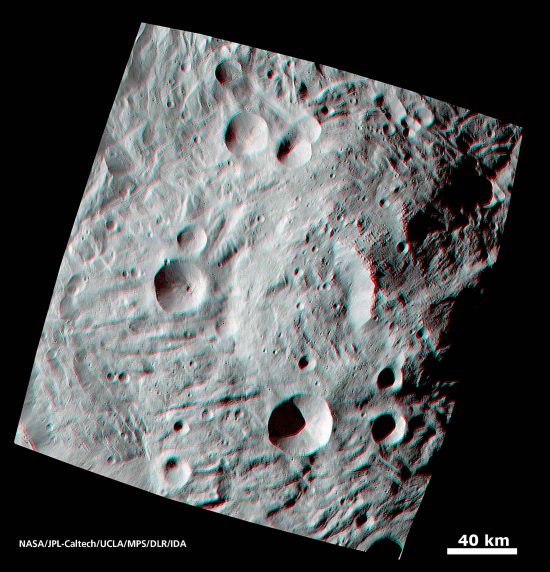Jul 5, 2019
More data analysis from the Dawn spacecraft.
Vesta experienced some powerful forces. There are craters more than 50 kilometers in diameter on its surface, even though it is a mere 564 kilometers by 531 kilometers. There is a particularly large crater near Vesta’s south pole that is 460 kilometers wide. It is remarkable that the asteroid was not blown to bits, particularly since the crater is about 13 kilometers deep, with an 18 kilometer high central peak.
According to a recent press release, data from the Dawn mission (currently in a “parking orbit” around the asteroid, Ceres) suggests that Vesta, rather than achieving its scarred condition in the initial protoplanetary nebula that gave rise to the Solar System, was hit by another asteroid after it was already solidified.
So-called protoplanetary disks are thought by the consensus to be where gravity pulls wispy gases together until they reach pressures great enough to ignite thermonuclear fusion, forming stars like the Sun. As the “Nebular Hypothesis” concludes, any remaining clumps of dust and gas not absorbed by the new star swirl around, attracting other bits, until they condense into planets. Asteroids are typically considered to be the “leftovers”.
A close examination of Vesta’s surface casts doubt on the notion that its large crater was created by an object smashing into it, especially since some of the smaller craters share walls that are thin and undisturbed by blast effects.
In an Electric Universe, shallow craters with overlapping rims are important considerations in the theory of electrical effects. Theories that invoke meteor impacts, landslides and other familiar geological forces, ignore an electrically dynamic Solar System in its formative phases, when cosmic thunderbolts carved the surfaces of planets and moons.
Newtonian impacts should form dish-shaped holes with a blanket of blast debris surrounding the rims, sorted from largest to smallest particles. Vesta reveals a different kind of landscape. Its craters are clean and most are found in collections, as if a shotgun blast struck it.
Electrical theory sees plasma discharges in the steeply carved cliffs on Vesta; features that are not easily explained by impacts. There are long canyons and furrows, some of which are ten kilometers wide, cut into the equator. A closer examination shows that those trenches (no matter what size) are chains of craters.
Asteroid formation does not require that one object smash into another one for there to be craters. Electric arcs can scoop out material, accelerate it into space, and leave behind deep pits. They tend not to disturb the surroundings, so they are used in industrial applications to finely machine metal parts. Based on laboratory analysis, that is what has occurred on Vesta: spark discharge erosion.
Planetary scientists ignore electrical explanations, which rectify the anomalies in other theories, because they know almost nothing about plasma and electric charge movement in space. Electricity can create the very things they are sending out probes to study.
Stephen Smith













